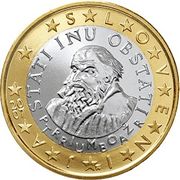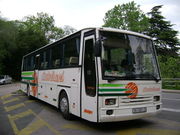Economy of Slovenia
| Economy of Slovenia | ||
|---|---|---|
| Currency | Euro (EUR) | |
| Fiscal year | Calendar year | |
| Trade Organisations | EU, WTO | |
| Statistics | ||
| GDP Ranking (2009) | 86th [1] | |
| GDP (2009) | EUR34.894 $48.474 current $51.938 PPP billion [2]]]),[3]. |
|
| GDP growth rate (2009) | -6.0% nominal -6.9% per capita nominal -7.8% real -8.7% per capita real |
|
| GDP per Capita (2009) | EUR17,092 $23,744 current $25,440 PPP |
|
| GDP by sector (2007) | primary (2.4%) industry (26.4%) construction (8.0) services (63.2%) |
|
| GDP structure (2007) | Private consumption (51.8%) Public consumption (17.8%) Investments (31.7%) Export (70.8%) Import (72.1%) |
|
| Inflation rate | 2009 0.9%, 02/2010 1.3% [4] | |
| Pop below poverty line (2008) | 12.3 %[5] | |
| Pop below Gini coefficient (2008) | 23.4 %[5] | |
| Employed Population (2008) | 942,473[6] | |
| Employed Population by occupation (2008) | primary (4.7%) secondary (37.6%) tertiary (57.7%)[6] |
|
| Unemployment rate | 6.2% (March 2010)[7] | |
| Main Industries | ferrous metallurgy and aluminum products, lead and zinc smelting; electronics (including military electronics), trucks, automobiles, electric power equipment, wood products, textiles, chemicals, machine tools | |
| Total exports | (2009 est.) $23.02 billion f.o.b. | |
| Main Partners (2008 est) | Germany 18.2%%, Italy 11.4%, Croatia 8.1%, Austria 7.3%, France 5.5%, Russia 4.7% | |
| Total imports | (2009 est.) $24.24 billion f.o.b. | |
| Main Partners (2008 est) | Germany 17.0%%, Italy 16.4%, Austria 11.1%, France 4.6%, Croatia 4.1% | |
| Current account balance 2008 | $-2.9 billion (-5.3% of GDP) [8] | |
| Public Finances | ||
| Total Public Debt (2008) | 22.8% of GDP [9] | |
| Revenues (2008) | 42.66% of GDP [10] | |
| Expenses (2008) | 43.61% of GDP [10] | |
| Budget Balance (2008) | -0.95% of GDP [9] | |
| Economic Aid (ODA) (2007) | EUR39.5 million (0.12% of GNI) [11] | |
Slovenia today is a developed country that enjoys prosperity and stability, as well as a GDP per capita at 91% of the EU27 average[12].
Contents |
History

Although it comprised only about one-thirteenth of Yugoslavia's total population, it was the most productive of the Yugoslav republics, accounting for one-fifth of its GDP and one-third of its exports.[13]
It thus gained independence in 1991 with an already relatively prosperous economy and strong market ties to the West.
Since that time, it has pursued diversification of its trade with the West and integration into Western and transatlantic institutions vigorously. Slovenia is a founding member of the World Trade Organization, joined CEFTA in 1996, and joined the European Union on 1 May 2004. In June 2004 it joined the European Exchange Rate Mechanism. The euro was introduced at the beginning of 2007 and circulated alongside the tolar until 14 January 2007. Slovenia also participates in SECI (Southeast European Cooperation Initiative), as well as in the Central European Initiative, the Royaumont Process, and the Black Sea Economic Council.
Current situation
Today, Slovenia is a prosperous country and has achieved the rank of a mainstream modern postindustrial economy. It advanced to the rank of advanced economies in 2007[14]. It benefits from a well-educated and productive work force, and its political and economic institutions are vigorous and effective. Its 2008 GDP per capita is now 91% of the European Union average[15]. Although Slovenia has taken a cautious, deliberate approach to economic management and reform, with heavy emphasis on achieving consensus before proceeding, its overall record is one of success.
The current account deficit began in 1998 (-US$147.2 million), deepened in 1999 to -$782.6 million, and improved slightly in 2000 on stronger exports to -$594.2 million. In 2008, Slovenia's economic growth reached 4.5%, annual inflation stood at 6% in 2008, and the debt to GDP ratio was well within Maastricht parameters. Due to its macroeconomic stability, favourable foreign debt position, and obvious interest in EU membership, Slovenia consistently receives the highest credit rating of all transition economies.
Trade

Slovenia's trade is orientated towards other EU countries, mainly Germany, Austria, Italy, and France. This is the result of a wholesale reorientation of trade toward the West and the growing markets of central and eastern Europe in the face of the collapse of its Yugoslav markets. Slovenia's economy is highly dependent on foreign trade. Trade equals about 120 % of GDP (exports and imports combined). About two-thirds of Slovenia's trade is with EU members.
This high level of openness makes it extremely sensitive to economic conditions in its main trading partners and changes in its international price competitiveness. However, despite the economic slowdown in Europe in 2001-03, Slovenia maintained 3% GDP growth. Keeping labour costs in line with productivity is thus a key challenge for Slovenia's economic well-being, and Slovenian firms have responded by specializing in mid- to high-tech manufacturing. Industry and construction comprise over one-third of GDP. As in most industrial economies, services make up an increasing share of output (57.1 percent), notably in financial services.
Economic performance

The traditional primary industries of Agriculture, forestry, and fishing comprise a comparatively low 2.5 percent of GDP and engage only 6 percent of the population. The average farm is only 5.5 hectares. Part of Slovenia lies in the Alpe-Adria bioregion, which is currently involved in a major initiative in organic farming. Between 1998 and 2003, the organic sector grew from less than 0.1% of Slovenian agriculture to roughly the European Union average of 3.3%.[16]
Public finances have shown a deficit in recent years. This averaged around $650 million per annum between 1999 and 2007, however this amounts to less than 23 percent of GDP.[17] There was a slight surplus in 2008 with revenues totalling $23.16 billion and expenditures $22.93 billion.[18] Government expenditure equalled 38 percent of GDP.[19] The national debt stood at 56 percent of the Gross Domestic Product [20].

Slovenia's traditional anti-inflation policy relied heavily on capital inflow restrictions. Its privatization process favoured insider purchasers and prescribed long lag time on share trading, complicated by a cultural wariness of being "bought up" by foreigners. As such, Slovenia has had a number of impediments to foreign participation in its economy. Slovenia has garnered some notable foreign investments, including the investment of $125 million by Goodyear in 1997. At the end of 2008 there was around $11.5 billion of foreign capital in Slovenia. Slovenians had invested $7.5 billion abroad. As of December 31, 2007, the value of shares listed on the Ljubljana Stock Exchange was $29 billion.
See also
- Bank of Slovenia
- List of banks in Slovenia
- List of companies of Slovenia
References
- ↑ "CIA GDP ranking". https://www.cia.gov/library/publications/the-world-factbook/rankorder/2001rank.html. Retrieved 2010-03-01.
- ↑ "Gross domestic product, annual data". Statistical Office - Slovenia. 2009-03-03. http://www.stat.si/eng/indikatorji.asp?id=20. Retrieved 2009-04-13.
- ↑ "OECD, PPP conversion rates". http://stats.oecd.org/Index.aspx?datasetcode=SNA_TABLE4. Retrieved 2010-03-01.
- ↑ "Inflation". Statistical Office - Slovenia. http://www.stat.si/eng/indikatorji.asp?ID=1. Retrieved 2010-03-01.
- ↑ 5.0 5.1
- ↑ 6.0 6.1
- ↑ Euro area unemployment rate at 10.0% - Eurostat. 30. April 2010
- ↑ "Balance of payments". Bank of Slovenia. April 2008. http://www.bsi.si/iskalniki/pregled-financnih-podatkov-en-vsebina.asp?VsebinaId=4098&MapaId=325. Retrieved 2009-04-14.
- ↑ 9.0 9.1 "Government deficit and debt". Statistical Office - Slovenia. April 2009. http://www.stat.si/eng/indikatorji.asp?ID=28. Retrieved 2009-04-14.
- ↑ 10.0 10.1 "General government accounts and EDP". Statistical Office - Slovenia. April 2009. http://www.stat.si/doc/vsebina/03/TemeljniAgregatiDrzaveANG.xls. Retrieved 2009-04-14.
- ↑ "International development cooperation and humanitarian assistance". Government of the Republic of Slovenia - Minbistry of Foreign Affairs. April 2009. http://www.mzz.gov.si/en/foreign_policy/international_development_cooperation_and_humanitarian_assistance/. Retrieved 2009-04-14.
- ↑ "GDP per capita in PPS - GDP per capita in Purchasing Power Standards (PPS) (EU-27 = 100)". Eurostat. http://epp.eurostat.ec.europa.eu/tgm/table.do?tab=table&init=1&language=en&pcode=tsieb010&plugin=1. Retrieved 2009-11-23.
- ↑ "Background Note: Slovenia". http://www.state.gov/r/pa/ei/bgn/3407.htm#econ. Retrieved 2009-05-04.
- ↑ IMF Country Groups (aggregated data)
- ↑ http://epp.eurostat.ec.europa.eu/tgm/table.do?tab=table&init=1&language=en&pcode=tsieb010&plugin=1
- ↑ Food First/Institute for Food and Development Policy | For Land, Liberty, Jobs and Justice
- ↑ The Economist
- ↑ https://www.cia.gov/library/publications/the-world-factbook/geos/si.html#Govt
- ↑ Fact date=March 2009
- ↑ The Economist Pocket World in Figures 2009
- "Ex-communist Slovenia adopts euro" (– Scholar search). Reuters via CNN.com. January 2, 2007. http://www.cnn.com/2007/WORLD/europe/01/02/slovenia.eurozone.reut/
- Ex-communist Slovenia joins euro. BBC News. January 1, 2007. http://news.bbc.co.uk/1/hi/world/europe/6222115.stm. Retrieved 2010-01-03
- Ali H. Zerdin (January 1, 2007) (– Scholar search). Slovenia adopts euro as new currency. Business Week. http://www.businessweek.com/ap/financialnews/D8MCF2684.htm
External links
|
|||||||||||||||||||||||||||||||||||
|
||||||||
|
|||||
|
||||||||||||||